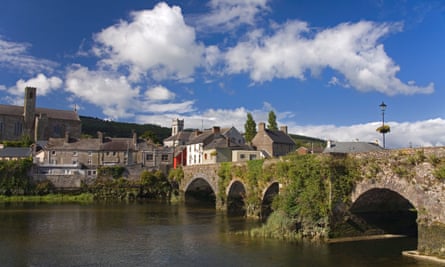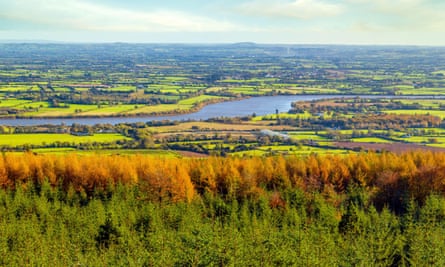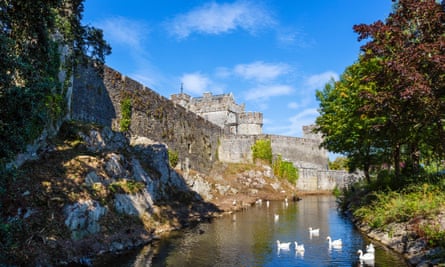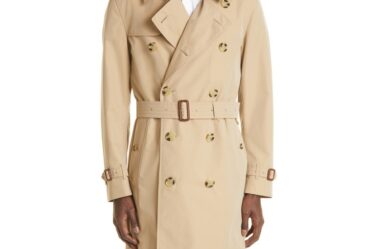
On a small weir by the riverbank, a heron stands motionless. I feel a quiet reverence as I glide past in my kayak, propelled by the fast-moving River Suir. It’s a bright morning and I’m getting a nature fix, kayaking from Clonmel to the village of Kilsheelan in County Tipperary.
I’m exploring a stretch of the Suir Blueway Tipperary – which runs between Cahir and Carrick-on-Suir – with a 53km paddling trail and a 21km walking and cycling trail along the river between Carrick and Clonmel. It’s one of three Irish Blueways that opened earlier this year. The others are the Lough Derg Blueway (also partly in Tipperary) and the Boyne Blueway in County Meath.
Greenways – traffic-free paths, usually built on disused railway lines or towpaths – have become popular in Ireland in recent years for walking and cycling. A Blueway introduces the element of water, encouraging the use of rivers, canals, lakes and coasts for activities such as kayaking and paddleboarding, while engaging with nature and heritage.
There’s plenty of both on the River Suir. The banks are lined with a riot of trees, the branches of willows reach down to the water and there’s birdsong all around. We see swifts, and my kayaking guide, Philip McCormack, explains how sand martins make their nests in the river’s mud banks. He tells me people often see kingfishers here for the first time.
Three mallards drift along as if escorting us. Later we are accompanied by mute swans, which show the power of their wings as they slowly – and noisily – take off over the water just ahead of us. We pass more grey herons; otters are often seen here too. I hadn’t expected the river to be so busy with life.
“It’s nice to kayak here for the tranquillity, seeing everything from a different angle, at the level of the water,” says Philip. “Nature is right in front of you. It’s the birdlife and the animals and a chance to de-stress. You can just sit there and let the river take you along and enjoy the views.”
This calm stretch is perfect for inexperienced kayakers. After three hours of relaxed paddling, we exit the water under one of the three arches of an old stone bridge at Kilsheelan village, and Philip tells me about the Butlers, a powerful Anglo-Norman family who owned land in the area for hundreds of years.
Ormond Castle in Carrick-on-Suir, 10 minutes by bus from Kilsheelan, was the home of the Butlers from 1309. It had a strategic location on the river. The Tudor manor was added in 1565 by Thomas “Black Tom” Butler, 10th Earl of Ormond and a cousin (and reputed lover) of Elizabeth I. The house still has much of the original decorative stucco plasterwork from the 1500s, so I drop in here for a tour before cycling the Blueway path back to Clonmel (about two hours).

The towpath along the river dates from the 17th century. Before roads, the river was the main form of transport, and horses drew yawls – shallow barges up to 18 metres long – along the waterway, taking goods from the tanneries, distilleries, mills and bakeries on Clonmel’s quay to Carrick-on-Suir and then to the port at Waterford, to travel to the wider world by sea.
Local records show that in 1835, there were 93 boats employing 200 men along this stretch of river. Now, its banks give walkers and cyclists access to a peaceful world of nature. The path is lined with woodlands – beech, ash, elder and elm trees filled with singing birds. In summer there are all sorts of wildflowers; in autumn it’s a blaze of red and gold.
I cycle past fishing huts with ladders leading down into the river, each belonging to a different fishing club. During the season, fishers in waders stand in the middle of the river in the shallow, clear water. They come here for wild salmon and brown trout – fishing is done on a catch-and-release basis.
I see stone boathouses, churches and, across the river, spy Castle Gurteen de La Poer, an Elizabethan manor now home to Austrian-born artist Gottfried Helnwein, and the neat rows of apple trees of the Bulmers (Magners) orchards. The company was founded on this lush land in 1935 and grows 17 varieties of apples over 101 hectares (250 acres) and on local farms to make its cider. The name Clonmel comes from the Irish cluain meala – meadow of honey.
In the distance are the Comeragh mountains on the County Waterford side of the river, and Slievenamon (from the Irish, Sliabh na mBan – mountain of the women) on the other. Kilsheelan Bridge is a good midway stop, so I drop into Maher’s foodstore for refreshments. A cafe has recently been opened, ready for the new Blueway visitors. Its owner, Miriam Maher, says the Blueway is a great amenity for locals and visitors.

The medieval town of Clonmel makes a pleasant base for exploring the river more, so I stay over and wander its pretty streets. Phil Carrolls, a traditional pub with muted lighting and cosy nooks and crannies full of memorabilia, is a good place for a drink. The next day at the Tipperary Museum of Hidden History I learn about the 1650 Siege of Clonmel by Oliver Cromwell’s army, plus tales of local history and folklore, and the River Suir’s importance as a trade route.
Other sites worth visiting on the route include Cahir Castle further west, which dates from the 13th century and was another Butler family stronghold. It is still well preserved, with original towers and a portcullis and trap, and there are guided tours. Just upriver, Swiss Cottage is a rose-covered ornamental thatched cottage built in the 19th century by Richard Butler for the gentry to spend leisurely summer days in. There are tours of the restored interior and forest and river walks outside.
Connecting standout cultural sights, while winding through the best of the countryside and riverside settlements, this Blueway offers a laid-back way of exploring. There’s are plans to eventually connect the Suir Blueway Tipperary to the Waterford Greenway and the South East Greenway (currently under construction) – and a possible future link from Cahir to Cashel. This river once played an important role connecting places like Carrick-on-Suir and Clonmel with the wider world, and it’s nice to think that this historic waterway has a future of new links and connections to continue its fascinating story.
The trip was provided by Tipperary Tourism and Blueway Bike Hire. Three-hour guided kayaking trips cost €50pp with Pure Adventure (out of season trips on request, depending on availability); bike hire half day €15 and full day €20 with Blueway Bike Hire. For maps and sample Blueway itineraries visit tipperary.com



